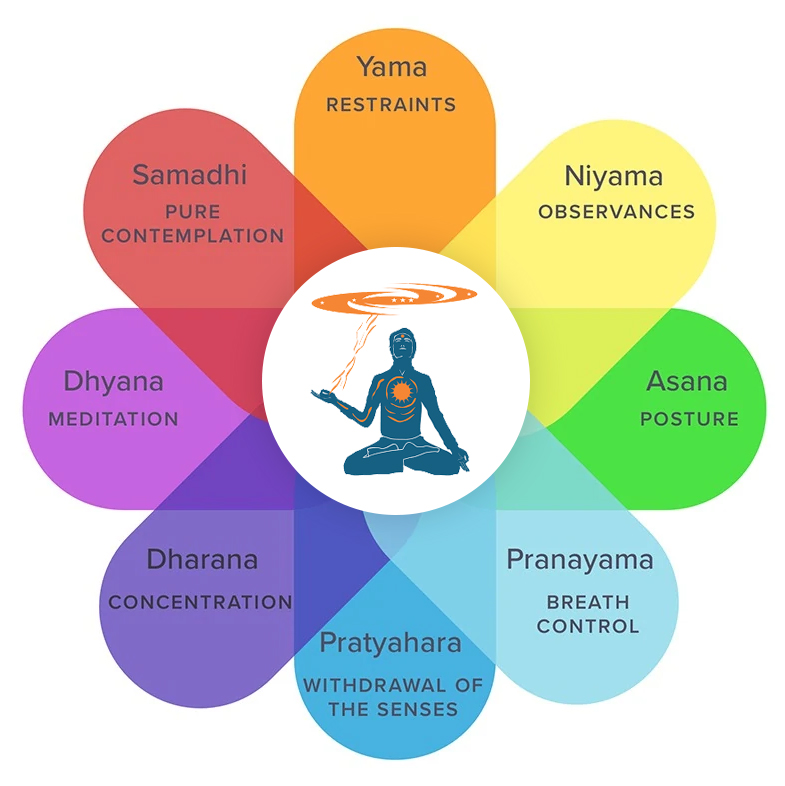Meaning of Yoga
The word Yoga comes from the Sanskrit word “Yuj” meaning to yoke, join or unite. Yoga (or Yog) is a continuous process of uniting leading to enlightenment. The techniques used to bring the body, mind and breath into harmony is called yoga. It is the Integration of all aspects of the individual – body with mind and mind with soul – to achieve a balanced, contented, effective life, and spiritually, ultimately uniting the individual with the supreme on a continuous basis, making the living of life an absolutely enjoyable one. Yoga is not religious but an activity to be Spiritual.


The Origin
The first yogi, God Shiv passed on the secret of living in perpetual ecstasy (the Yogic techniques through his teachings known as Shiva Sutras) to his counter part Shakti Parvati. Later on, on insistence of Shakti Parvati, he shared the wisdom to his primary disciples, the seven most evolved beings, popularly known as Saptharishis (seven Spiritual saints) who in turned spread the divine secrets world wide. All Indian scriptures like Vedas, Upanishads, Puranas contain various references regarding yogis and yogic practices. Hatha Yoga Patrika (manual) is a technical manual on yoga.
Contribution of Patanjali
Around 2200 years ago Patanjali, widely known as the Father of Yoga, methodically brought various philosophies and methodologies of yoga from various sources in one concise, integrated and comprehensive text as a set of 196 aphorisms called “The Yoga Sutras”. These Sutras are considered as the most profound and enlightening study of the human psyche. Patanjali categorically demonstrates how the practice of Yoga results in our transformation by gaining mastery over the mind and emotions. It even helps us to overcome the obstacles of our spiritual evolution and attain the goal of yoga – the liberation from the bondage of worldly desires.
In the four chapters of his sutras he explains the levels of higher consciousness (Samadhi) which the aspirant experiences before reaching Kaivalya (emancipation) and the end of this world’s spiritual pursuit. The second chapter deals with the methodology which must be followed to reach Samadhi and the hindrances which may be encountered.
The unusual powers that may develop are also described with the warning that their lure must be avoided, while the final chapter covers the achievement of Kaivalya in detail. Being a realized master, through his evolved consciousness he shared a balanced perspective and prescribed “Ashtanga Yoga”, the eight limbs of yoga, as –
- Yama – Restraints by clinging on to the universal ethics such as non-violence, truthfulness, non-stealing, sexual restraint and non-acquisitiveness.
- Niyama – Adhering to the principles of self conduct: purity, contentment austerity, study of self and scriptures and self-surrender.
- Asana – Practice of the body postures.
- Pranayama – Breath control by adapting various breathing techniques.
- Pratyahara – Withdrawal and control of the senses.
- Dharana – Concentration.
- Dhyana – Meditation.
- Samadhi – Establishing in the state of higher consciousness where the sense of self (ego) dissolves in the object of meditation and the individual self exists in its own pure nature.

Paths of Yoga
Largely there are four primary paths that lead to liberation, “Kaivalya.” They are widely known as Karma Yoga, Bhakti Yoga, Raja Yoga and Jnana Yoga.
To be very frank, these are all definitely not exclusive paths. Since every individual is unique, everyone needs a different combination of these four primary paths. Over a period a few branches of yoga evolved from the original path with slight variations.
It must be clearly understood that there are no clear cut boundaries between these various paths as the practice and philosophy of each one often get overlapped with one another. Most certainly, the original path is filled with clear and concise structure with the core benefit of Yogic philosophy.

Importance of Yoga
Largely there are four primary paths that lead to liberation, “Kaivalya.” They are widely known as Karma Yoga, Bhakti Yoga, Raja Yoga and Jnana Yoga.
To be very frank, these are all definitely not exclusive paths. Since every individual is unique, everyone needs a different combination of these four primary paths. Over a period a few branches of yoga evolved from the original path with slight variations.
It must be clearly understood that there are no clear cut boundaries between these various paths as the practice and philosophy of each one often get overlapped with one another. Most certainly, the original path is filled with clear and concise structure with the core benefit of Yogic philosophy.
